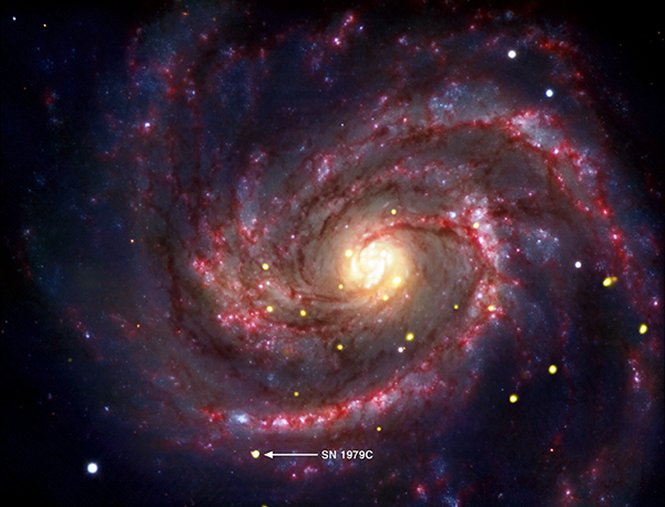Added 2 new A* pages:Yes, if you were wondering in what garb galactic assassins lounge around their lunar bases, now you know that flip-flops and cargo shorts are definitely included.
~~~~~~~~~
I came across a couple new black-hole science links in the past few days!
NASA announced that they think they may have discovered the youngest nearby black hole; from 1995-2007, multiple X-ray telescopes studied supernova remnant SN 1979C--light from whose supernova explosion reached Earth in 1979--and it seems to have been emitting X-rays steadily for that whole time. One thing thought to result from supernovae, and to emit X-rays, would be a black hole sucking in remaining loose matter.

composite image by NASA (source); X-ray data is in gold
They're particularly encouraged to think that they've detected a stellar black hole in this case because no gamma ray burst was detected with this supernova, but it did contain hydrogen, which means it was a type II supernova, thought to be the type of supernova that produces most black holes. (In contrast, most supernovae detected have been--I think--type 1a supernovae, which are explosions of relatively small white dwarf stars, and unlikely to have sufficient mass to produce a black hole (a star of 20 stellar masses is thought to be required to produce a black hole; type 1as go boom when they hit the Chandrasekhar limit of only 1.38 solar masses).) It's also somewhat exciting because SN 1979C is "only" 50 million light years away (In galaxy Messier 100), whereas the type 1a supernovae detected by their emitted gamma ray bursts are often billions of light years away.
Still, calling it the "youngest nearby black hole" is a neat bit of hyperbole, because--aside from the fact that there are almost certainly many stellar black holes in our own galaxy, on the order of just tens of thousands of light years away from Earth--they can't really be sure this X-ray-emitting-thing is a black hole; even if it is a remnant of the supernova explosion detected in 1979, it could be a pulsar rather than a black hole. Also, because it's 50 million light years away, that makes it at least 50,000,030 years old.
So really this article illustrates just how darn hard it is to find black holes!
~~~~~~~~~~
Aside, that is, from the supermassive ones now thought to exist at the center of pretty much every galaxy. And the first half of this new Sixty Symbols video has an interesting discussion about what happens when those black holes collide: (Link to it on YouTube for those reading via RSS.)
So black holes continue to make the news more and more often. Eventually they might be the *only* news in the universe... :o
|
